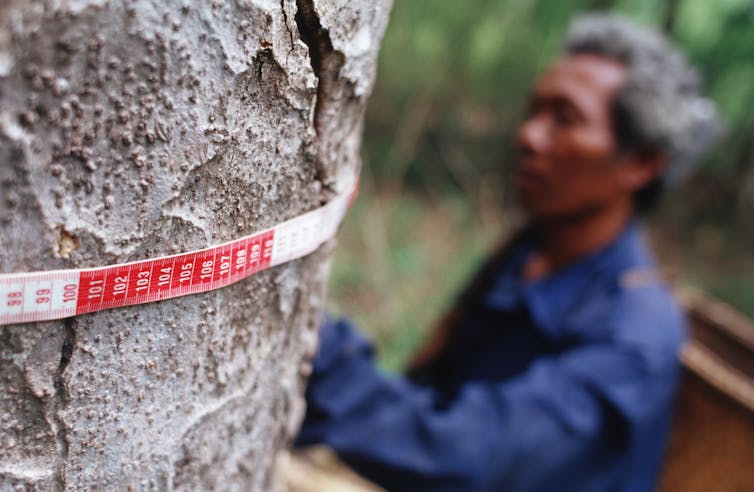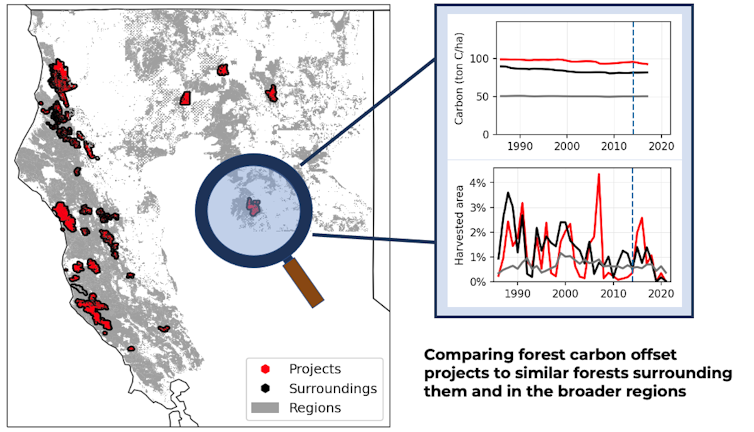
Many of the companies promising “net-zero” emissions to protect the climate are relying on vast swaths of forests and what are known as carbon offsets to meet that goal.
On paper, carbon offsets appear to balance out a company’s carbon emissions: The company pays to protect trees, which absorb carbon dioxide from the air. The company can then claim the absorbed carbon dioxide as an offset that reduces its net impact on the climate.
However, our new satellite analysis reveals what researchers have suspected for years: Forest offsets might not actually be doing much for the climate.
When we looked at satellite tracking of carbon levels and logging activity in California forests, we found that carbon isn’t increasing in the state’s 37 offset project sites any more than in other areas, and timber companies aren’t logging less than they did before.
The findings send a pretty grim message about efforts to control climate change, and they add to a growing list of concerns about forest offsets. Studies have already shown that projects are often overcredited at the beginning and might not last as long as expected. In this case we’re finding a bigger issue: a lack of real climate benefit over the 10 years of the program so far.
But we also see ways to fix the problem.
How forest carbon offsets work
Forest carbon offsets work like this: Trees capture carbon dioxide from the air and use it to build mass, effectively locking the carbon away in their wood for the life of the tree.
In California, landowners can receive carbon credits for keeping carbon stocks above a minimum required “baseline” level. Third-party verifiers help the landowners take inventory by manually measuring a sample of trees. So far, this process has only involved measuring carbon levels relative to baseline and has not leveraged the emerging satellite technologies that we explored.
Forest owners can then sell the carbon credits to private companies, with the idea that they have protected trees that would otherwise be cut down. These include large oil and gas companies that use offsets to meet up to 8% of their state-mandated reductions in emissions.

Forest offsets and other “natural climate solutions” have received a great deal of attention from companies, governments and nonprofits, including during the U.N. climate conference in November 2022. California has one of the world’s largest carbon offset programs, with tens of millions of dollars flowing through offset projects, and is often a model for other countries that are planning new offset programs.
It’s clear that offsets are playing a large and growing role in climate policy, from the individual to the international level. In our view, they need to be backed by the best available science.
Three potential problems
Our study used satellite data to track carbon levels, tree harvesting rates and tree species in forest offset projects compared with other similar forests in California.
Satellites offer a more complete record than on-the-ground reports collected at offset projects. That allowed us to assess all of California since 1986.

From this broad view, we identified three problems indicating a lack of climate benefit:
- Carbon isn’t being added to these projects faster than before the projects began or faster than in non-offset areas.
- Many of the projects are owned and operated by large timber companies, which manage to meet requirements for offset credits by keeping carbon above the minimum baseline level. However, these lands have been heavily harvested and continue to be harvested.
- In some regions, projects are being put on lands with lower-value tree species that aren’t at risk from logging. For example, at one large timber company in the redwood forests of northwestern California, the offset project is only 4% redwood, compared with 25% redwood on the rest of the company’s property. Instead, the offset project’s area is overgrown with tanoak, which is not marketable timber and doesn’t need to be protected from logging.

How California can fix its offset program
Our research points to a set of recommendations for California to improve its offsets protocols.
One recommendation is to begin using satellite data to monitor forests and confirm that they are indeed being managed to protect or store more carbon. For example, it could help foresters create more realistic baselines to compare offsets against. Publicly available satellite data is improving and can help make carbon offsetting more transparent and reliable.
California can also avoid putting offset projects on lands that are already being conserved. We found several projects owned by conservation groups on land that already had low harvest rates.
Additionally, California could improve its offset contract protocols to make sure landowners can’t withdraw from an offset program in the future and cut down those trees. Currently there is a penalty for doing so, but it might not be high enough. Landowners may be able to begin a project, receive a huge profit from the initial credits, cut down the trees in 20 to 30 years, pay back their credits plus penalty, and still come out ahead if inflation exceeds the liability.
Ironically, while intended to help mitigate climate change, forest offsets are also vulnerable to it—particularly in wildfire-prone California. Research suggests that California is hugely underestimating the climate risks to forest offset projects in the state.
The state protocol requires only 2% or 4% of carbon credits be set aside in an insurance pool against wildfires, even though multiple projects have been damaged by recent fires. When wildfires occur, the lost carbon can be accounted for by the insurance pool. However, the pool may soon be depleted as yearly burned area increases in a warming climate. The insurance pool must be large enough to cover the worsening droughts, wildfires and disease and beetle infestations.
Considering our findings around the challenges of forest carbon offsets, focusing on other options, such as investing in solar and electrification projects in low-income urban areas, may provide more cost-effective, reliable and just outcomes.
Without improvements to the current system, we may be underestimating our net emissions, contributing to the profits of large emitters and landowners and distracting from the real solutions of transitioning to a clean-energy economy.
Shane Coffied is a post-doctoral scientist in biospheric sciences at NASA’s Goddard Space Flight Center. James Randerson is a professor of earth science at the University of California, Irvine. This article was originally published at The Conversation.
Weekly Newsletter
Get building science and energy efficiency advice, plus special offers, in your inbox.













3 Comments
I swore I wouldn't stick my head up after nearly getting it nearly chopped off recently for talking about a related subject: burning wood in Europe to generate electricity.
https://www.greenbuildingadvisor.com/article/countries-increase-biomass-subsidies-despite-cop-27-pledge
However, GBA has contributed a valuable article here and I live in the region that this article is discussing. Carbon offsets in California seem to be another greenwashing technique, just like wood pellets used for generating electricity in Europe. I hadn't known about this subject, so I appreciate GBA bringing it to my attention, and I believe what this article is saying. My intuition tells me that the authors' research is valid and commercial interests have again subverted and diverted the intent of an intended conservation effort. This is very similar to big oil trying to convince everyone that they are really on the side of the planet.
"Real" sequestering of carbon from forests requires something quite different from a haphazard carbon offset program. Again, what is really happening seems to be corporate interests trying to hoodwink everyone, and they appear to have been successful with many people.
Carbon offsets doesn't seem to work. I think my suggestion to the article linked above along with similar comments from other people, applies here. Along with giving up on carbon offsets we shouldn't be clearcutting forests in an effort to justify reducing fire risk. Nor should we burn non-commercial trees for the same reason, because that just adds to the CO2 load of the atmosphere. There needs to be selective logging that is separate from what the current logging industry does for construction. I hope individuals here can understand that.
Again, waste timber needs to be sequestered and it seems to me the best current way of doing is by making it into insulation. This includes selective cutting down of trees (not clear cutting) for forest fire mitigation. I'm sure there are other products that will be developed from wood waste in time.
It may not be currently commercially viable to do selective logging for fire mitigation and then use it to form products, like insulation, that sequesters carbon. Government can play a role to get the seed money to get the ball rolling. I get so tired of a few assholes here that always have a go to position that any suggestion that would require taxpayer money is part of some grand conspiracy, or that government is always a problem and can never be the answer. I don't ever see those same people complaining about getting their social security income when they retire. "Some" things just can't be done without government. It's not political to say that. It's a fact. Because government does not handle everything correctly and sometimes get its priorities wrong doesn't negate that. Name anything in life created by man that is perfect. Imperfection is not an excuse for the rampant "whataboutism" that exists on social media. That's just bullshit.
exeric, while I generally share your point of view, it's the internet so any remotely controversial topics will always generate comments that raise hackles. Heck, at least half the reason they comment is simply to raise hackles.
That said, using swear words to describe them is not really appropriate for this site, and may even violate the terms of service. I recommend editing your comment before an editor takes care of it for you.
I'm curious as to why comments are allowed to stay up that include calling people with a different view on things "Assholes" before any additional comments are made.
Log in or create an account to post a comment.
Sign up Log in